How have Martin Parr and Mark Power explored the concept of the weather in their work?
“I was looking for pictures that were visual metaphors for the spoken words” – Mark Power in an online interview with Joanna Creswell.
The study of weather in photography is situated within the genre of landscape but can be linked with the theory of the Sublime, pictorialism and realism. This suggests how the concept of weather is used in photography and art to transform the outcome of images. These images can appear through dark and gloomy days where the sun hides away, or bright and overexposed on days when the sun is gleaming high above in the sky. Martin Parr and Mark Powers make photographs in different ways, but both pay attention to the weather, which can be viewed as a British obsession. This is seen in Parr’s work and his project ‘Bad Weather’ where he takes a documentary approach to image-making, whereas Power’s project ‘The Shipping Forecast’ focuses of the metaphorical concept of weather and how the radio broadcast (of which his project originated from) can be helpful and creates a sense of comfort for those who are listening. This exploration of different landscapes is vital and important within Jersey because it raises awareness of places people may not have seen before such as Fern Valley or Swiss Valley – places which are unlike the coasts that Jersey is most known for such as St. Brelades Bay or St. Ouen’s. Therefore, the concept of weather plays a major part in the outcome of images because it alters the way woodland areas appear; some are muddy and wet whereas others are relatively dry. But this did not impact the way that nature still carries on in unique ways which can romanticise the landscape, such as fungi taking over the forest floor, or the way that leaves wrapped around a tree and reflections of the nature in puddles of water.
The concept of weather in realism and pictorialism photography
The concept of weather in photography can be seen in the theory of the Sublime, developed by Edmund Burke in the 18th Century. This theory focuses on how the Sublime is viewed. On the Tate website, it states ‘He [Burke] defined the sublime as an artistic effect productive of the strongest emotion the mind is capable of feeling.’ (Tate, n.d.) This is used to show how Burke defined the theory of the Sublime into different feelings such as terror and fear, obscurity and power. These categories are used to describe how an artistic image can create the strongest feelings of emotion which the mind can produce and how these will always be products of the Sublime within art and photography. The Sublime is used within the genre of landscape as it influenced early painters, such as J.M.W. Turner’s work of sea storms and different mountain scenes as well as the German painter, Caspar David Friedrich such as his painting “The Sea of Ice” made in 1823-24. The use of the Sublime is viewed as a path into the development of Pictorialism in photography, this originated during the 1880s-1920s and it focuses on how photography was a process similar to creating a piece of art using techniques that would mimic painterly effects, whereas Realism, depicted how photographers captured the accuracy of the real world through the optic camera. In an online article, Lauren Adolf writes, “It was naturalistic and real, rather than ethereal and modified. The images were minimal, however beautifully composed.” (Adolf 2021) This explained how photographers were beginning to move away from Pictorialism and focus on creating natural images through different landscapes, architecture and objects alongside the concept of weather. Many people criticised Straight Photography, claiming that it does not show the artistic and photographic process celebrated within Pictorialism, but many photographers have shared elements of these ‘isms’ within their works. This is because many people claimed how Realism did not hold the same manipulation techniques as Pictorialism, which included using soft-focusing, smearing Vaseline on the lens to give it a painterly effect, the use of different filters, and allegorical forms. There are a variety of photographers who were influenced by the theory of Sublime within their work and experiment with both Pictorialism and Realism. This is shown in the work of the photographer, Alfred Stieglitz. Stieglitz wrote how ‘the works could express pure emotion, paralleling the artist’s own inner state.’ (The Alfred Stieglitz Collection, 2016) This describes the inner process in which Stieglitz carried out to create many of his works as they represented his thoughts and feelings following the theory of the Sublime, which can be seen in works such as his ‘Equivalents’, a series of images produced in 1923. This is of images regarding clouds during different weather conditions and how they are used to provoke different emotions within a person’s mind, showing the theory of Sublime. In comparison, the theory of Sublime within the genre of landscape photography can be shown in both Caspar David Friedrich’s work which is mentioned above, as well as Alfred Stieglitz’s work. This is because Friedrich’s painting “The Sea of Ice” shows how the ice is used to represent the fear and terror that can be created by these ice formations which evokes a sense of power of how the painted image can manipulate the way your mind perceives reality. This painting holds similarities and differences to Stieglitz’s work in ‘Equivalents’ provokes the feeling of obscurity due to the formation of the clouds and how Stieglitz uses this to create a sense of fear due to how the clouds holds a dark colour within them. Therefore, both images represent the genre of landscape as they can be viewed within a theoretical framework of the concept of the Sublime and how this is linked towards the change from Pictorialism to Realism in art and photography.

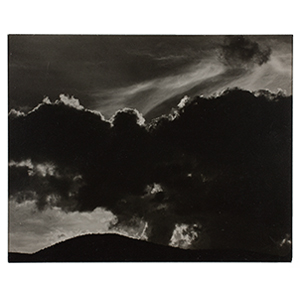
Martin Parr
Throughout Martin Parrs work, he represents a documentary approach when photographing weather which is more associated with photojournalism and editorial photography. Parr has used a variety of techniques over time. In an online article titled ‘How does Martin Parr take a photo?’ it describes all the different techniques he used, from the 1970s in early black and white photography to the mid 2000’s where he switches to digital photography. For example, by 2017 he is using a wider-angle lens which allows him to observe a scene from a larger perspective. This can be seen in Parr’s early project called ‘Bad weather’ where he experiments with the concept of weather within photography. ‘Bad Weather’ is labelled as a project which focuses on the British obsession with the weather, as it is a topic of conversation that many of us discuss daily. Although many photographers tend to avoid photographing in bad weather, Parr decides to discuss it through his photography. On the website ‘The Photographers Gallery’, it states “He feels that bad weather often creates an atmosphere lacking in bright, sunny weather, has gone out to see how bad reveals the character of the things we see.” (thephotographersgallery.org.uk, n.d.) and this quote reveals how Parr imagines that the weather, whether it is good or bad, represents the characteristics in which we cannot see and how it creates an atmosphere depending on the weather, whether it is windy or rainy. One of the photographs from ‘Bad Weather’ called “Jubilee Street Party Elland, Yorkshire” taken in 1977 is said to be one of the most popular images from Parr’s series, (Huxley-Parlour Gallery, 2013). This is because it shows a deserted street of where there once were celebrations taking place which was destroyed and abandoned due to the change of weather. This creates an element of juxtaposition within the photo as the table is still laid formally with cakes and plates although the tablecloths are seen to be blowing within the wind and the rain is seen to be lashing down, showing the happiness of celebrations but contrasted with the dreary and glum from the bad weather, as if it wants to ruin it. This creates an eerie atmosphere within the photo. This is because it shows how the weather ruins scenes where people were enjoying themselves, but in a comical and humorous way due to how the scene remains as it were and no one has bothered to tidy up, as if they were expecting it to happen, or even waiting for it.
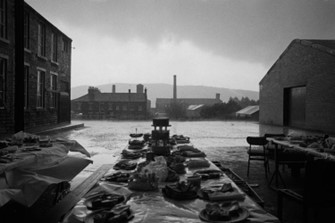
Mark Power
Mark Power’s is another British photographer, who focuses on the metaphorical concept of weather within photography. Power has produced a book called Shipping Forecast that follows a journey of the British institution of ‘The Shipping Forecast’. This is a broadcast that runs four times a day on BBC Radio 4 and is used to help mariners know what weather to expect when they are out on their boats, which is crucial in life-or-death situations, as it splits the waters of Western Europe into 31 sea areas, from Dover to German Bright. The broadcast is also listened to by many because it holds a soft, poetic voice which many find comforting as it creates these whimsical images of places many of us only imagine, while describing if it is raining, snowing and so on. In an online article from Magnum Photos, Power’s explains his intentions for the project when he states, “The project was about those of us – and we are in our millions – who, through the Forecast, experience a reinforced sense of ‘Britishness’.” Powers uses this comment because it shows how he used the concept of weather in his photography. This is because the weather is a British obsession, stated previously by analysis of Martin Parr’s work, and is used by many British people in conversations as it is a topic which many of us discuss when we talk to one another which reinforces that sense of identity within the theme of ‘Britishness’ as it creates a community in which we can all relate too. Another comment is made by Joanna Cresswell, the producer of the online article about Power’s work. She states “Power’s photographs – black and white, enigmatic and brooding – offer a complementary dichotomy of romance and threat; oscillating between whimsy and foreboding as storm clouds merge above the people he photographs.” (Cresswell, 2018) and this describes the overall theme of juxtaposition, showing the safety the broadcast provides but the lingering threat of the dangers at sea, that Power has created for ‘The shipping forecast’. One of Power’s images called TRAFALGAR depicts the vision of this quote from Cresswell, because the photograph represents that ‘threat’ of what sea creatures are lingering beneath the sea. This is using the shadowed figured, which gives a contorted look due to its position. It could represent a sea monster and the uncertainty of not knowing what may be in large areas of the sea that many of us are yet to explore. On the other hand, the photograph could also represent the ‘romance’ of travelling around and not knowing what you may stumble across as the picture is in black and white, which could be used to represent places that have not been visited before and the uncertainty behind it, which romanticises the fear of the unknown as it makes us excited. Therefore, Power’s work links well within the concept of weather in photography because his work represents the uncertainty of what we may encounter when we are travelling around by boat at sea, but his work also creates the comfort and security which many people feel when listening to ‘The Shipping Forecast’ on BBC Radio 4.
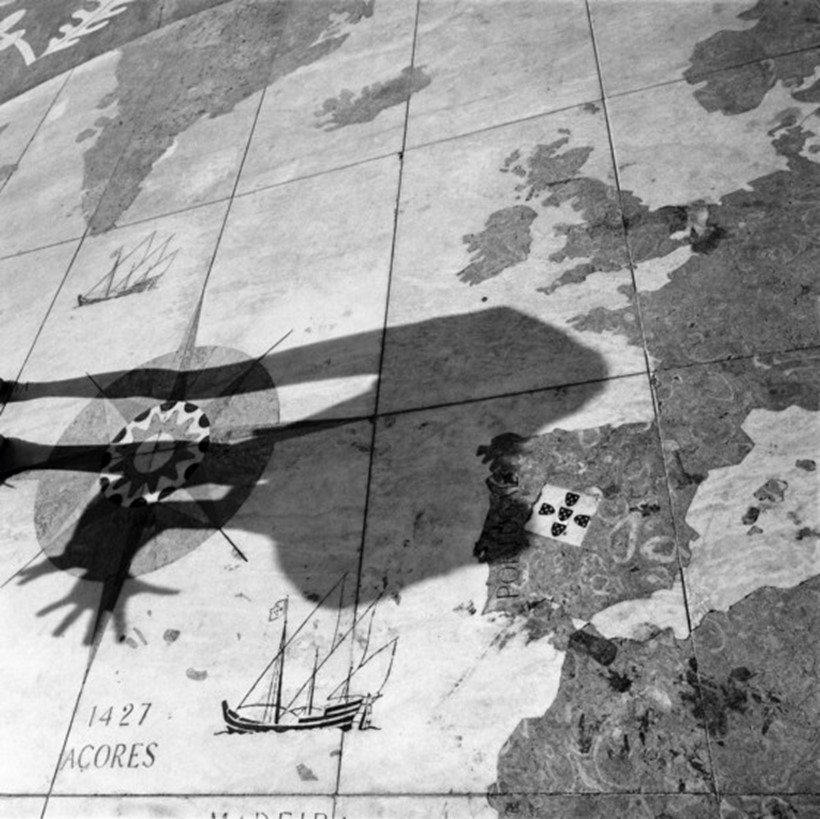
Conclusion
Martin Parr and Mark Power’s share both similarities and differences within their work. The differences within their work are evident, this is because we can see how Martin Parr takes a documentary approach within his work as he records the British obsession of weather, and how it can completely change the outcome of a scene and the atmosphere which is being created due to the weather. In Power’s work it is shown that he takes a metaphorical approach within his work where he uses his photographs to create an imaginative story of what may lie within the sea boundaries and its maritime communities within. There are also some similarities which they share within their work, and this is seen through the concept of how they both view weather as a British phenomenon and how they understand that many photographers avoid photographing in weather conditions such as rain, windy, damp, but Parr and Power see this as a British way to create a sense of identity and focus on ‘Britishness’ as well as how unusual yet unique the characteristics of bad weather can be and what stories they can create. In my own work, I wanted to encapsulate the concept of weather within nature, unlike Parr and Power because I think that the impact of weather can completely change the way it effects nature such as leaves, trees and plants to represent Power’s influence on my work, where it contains a comforting yet whimsical effect. In both Power’s and Parr’s work they have also used people within their photographs to create a further sense of story and narrative. This is an element which I have carried through my work as well when I have been out for walks with my family and our dog. I think that this element of people and animals, although it may only be a few, adds a feeling of comfort to my images as it makes them seem more homely and carries that assuring feeling that I have wanted to create throughout my photobook.
Examples of my work –
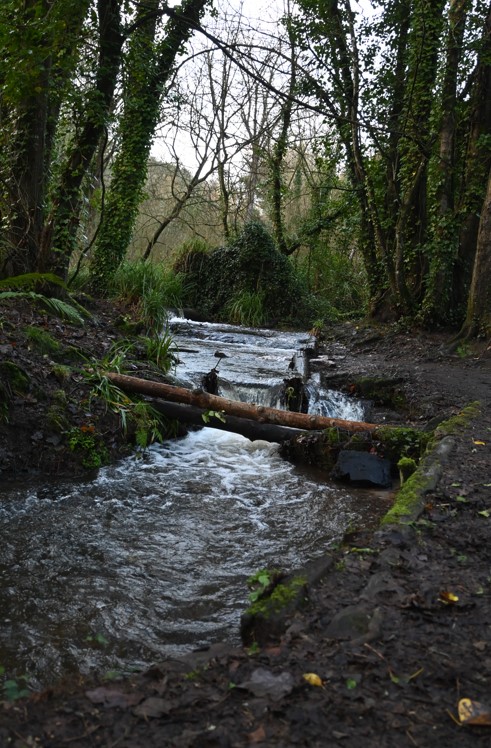
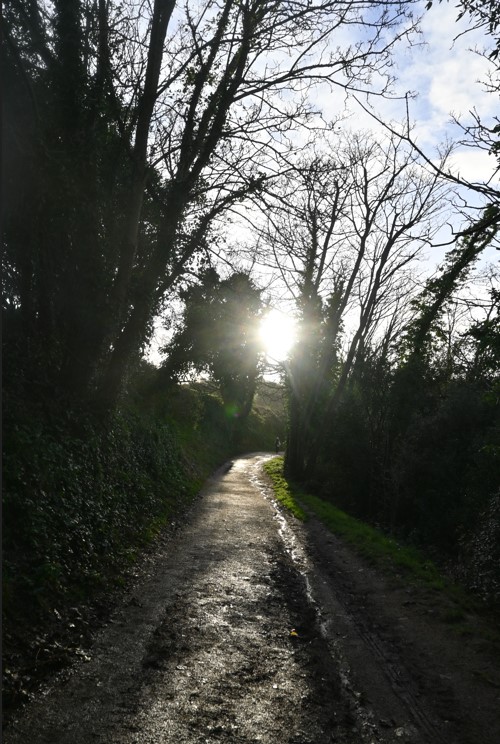


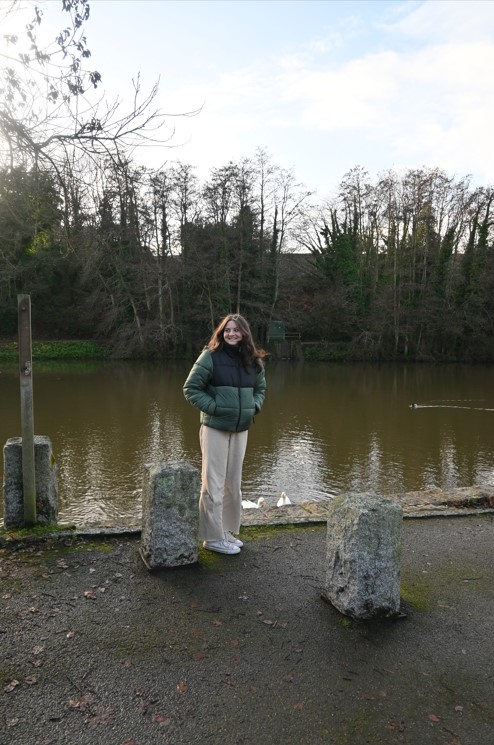
Bibliography
- Nast, C. (2022). Vanessa Winship recounts her wanderings through the winter landscape. [online] Vogue. Available at: https://www.vogue.com/article/vanessa-winship-recounts-her-wanderings-through-the-winter-landscape [Accessed 11 Jan. 2023].
- Adolf, L. (2021). AH 331 History of Photography Spring 2021 Compendium: Pictorialism versus Straight Photography: An Argument of Artfulness. [online] AH 331 History of Photography Spring 2021 Compendium. Available at: https://scalar.chapman.edu/scalar/ah-331-history-of-photography-spring-2021-compendium/lauren-adolph-essay-3 [Accessed 12 Jan. 2023].
- The Alfred Stieglitz Collection. (2016). The Alfred Stieglitz Collection | Straight Photography. [online] Available at: https://archive.artic.edu/stieglitz/straight-photography/ [Accessed 12 Jan. 2023].
- Tate (n.d.). Sublime – Art Term. [online] Tate. Available at: https://www.tate.org.uk/art/art-terms/s/sublime#:~:text=The%20theory%20of%20sublime%20art [Accessed 19 Jan. 2023].
- The Nature of Writing. (n.d.). Edmund Burke on the Sublime | Literary Theory. [online] Available at: https://natureofwriting.com/courses/literary-theory-1/lessons/edmund-burke/topic/the-sublime/ [Accessed 19 Jan. 2023].
- www.rmg.co.uk. (n.d.). How does Martin Parr take a photo? [online] Available at: https://www.rmg.co.uk/stories/topics/how-does-martin-parr-take-photo [Accessed 23 Jan. 2023].
- thephotographersgallery.org.uk. (n.d.). Martin Parr: Bad Weather | The Photographers Gallery. [online] Available at: https://thephotographersgallery.org.uk/whats-on/martin-parr-bad-weather [Accessed 23 Jan. 2023].
- Huxley-Parlour Gallery. (2013). Bad Weather – Huxley-Parlour Gallery. [online] Available at: https://huxleyparlour.com/critical-texts/martin-parrs-bad-weather/ [Accessed 24 Jan. 2023].
- Cresswell, J. (2018). The Shipping Forecast • Mark Power • Magnum Photos. [online] Magnum Photos. Available at: https://www.magnumphotos.com/arts-culture/society-arts-culture/mark-power-the-shipping-forecast/ [Accessed 24 Jan. 2023].
- Diaz, A. (1981). Robert Adams Beauty in Photography. www.academia.edu, [online] pp.20–36. Available at: https://www.academia.edu/33248645/Robert_Adams_Beauty_in_Photography [Accessed 27 Jan. 2023].

Emily, your essay question is both intriquing and complex at the same time and I think you should approach it slightly in a different way the way I describe it here, which means you will have to rewrite some of your introduction and Pg1.
Weather is a natural phenomena and images in art and photography situated within the genre of landscape. I will show you some key texts and images in class
Pg 1: Discuss theory around the Sublime developed by Edmund Burke in 18th C and how it influenced early landscape painters, such as J.M. Turner. Discuss Alfred Stieglitz switch from Pictorialism to Realism with reference to key works, ‘Equivalents’ etc that you have already written. Apply theory of the sublime to Stieglitz work and also compare it to Turner’s painting, eg. Snow Storm Steam Boat of Harbour’s Mouth
https://www.tate.org.uk/art/artworks/turner-snow-storm-steam-boat-off-a-harbours-mouth-n00530
https://www.tate.org.uk/art/art-terms/s/sublime
Youtube on Burke/ Sublime:
https://youtu.be/BvzG_p_sdOQ
This article picks out key elements of Burke’s theory of the Sublime and also includes an analysis of painting by Casper David Friedrich
https://natureofwriting.com/courses/literary-theory-1/lessons/edmund-burke/topic/the-sublime/
Pg 2: Martin Parr represents a documentary approach to photographing weather using different photographic techniques (use of flash etc) more associated with photojournalism/ newspaper photography. I don’t have Parr’s book ‘Bad Weather’ in my collection but he does talk about this project in other books – i’ll show you in class.
Read chapter ‘Vernacular’ in Martin Parr retrospective book by Val Williams
A comment here from a critic on Bad Weather
https://thephotographersgallery.org.uk/whats-on/martin-parr-bad-weather
https://huxleyparlour.com/critical-texts/martin-parrs-bad-weather/
Maybe consider comparing Parr’s images of bad weather with another British photographer, Mark Power and his book, ‘Shipping Forecast’. Think about how Parr’s/ Power’s images of weather and landscape is a broader comment and broader portrait of British culture and identity
Pg 3: Vanessa’s approach is more poetic and lyrical in line with Robert Adams. Read his text ‘Beauty in landscape photography’ and analyse/ interpret her work in relation to this text. Read first chapter
https://www.academia.edu/33248645/Robert_Adams_Beauty_in_Photography
Find interviews with her where she talks about his influence on her work
In his video Winship picks some of her key photobook inspirations incl. Summer Nights by Robert Adams (13 mins in)
https://youtu.be/kxW_yZQXCms
Winship interview on her book Snow and idea of wandering and photography
https://www.vogue.com/article/vanessa-winship-recounts-her-wanderings-through-the-winter-landscape
Conclusion: Draw on similarities and differences between both artists above and analyse/ evaluate your own photographic responses (provide examples)
Illustrations: make sure you use illustrations of artists work + your own. Caption each illustration with artists, name, title, year
Bibliography: list all sources using Harvard
Emma, I have made some changes directly in the text for more clarity and better flow of language. Try and avoid using too many etc. Here is a couple of things to finish it.
1. Text in italic needs re-writing/ re-phrasing
2. Make sure all quotes are done using Harvard referencing
3. Remove essay plan at front and change title from Essay draft to Final Essay
Almost there…well done!